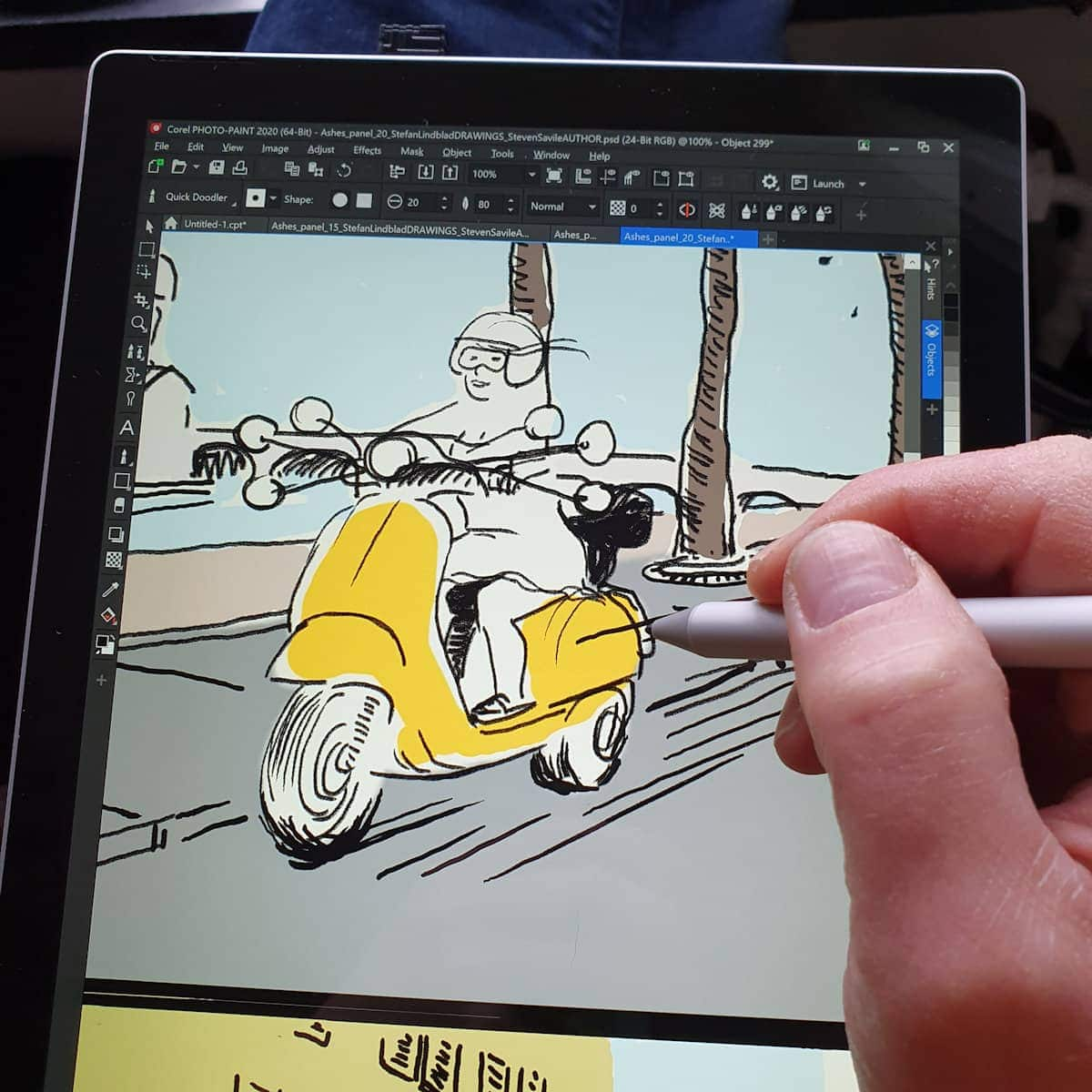From full-time freelance illustrator and designer, Stefan Lindblad
Some of the biggest challenges of working from home are maintaining self-discipline, avoiding unnecessary procrastination, and staying focused – with many different distractions around you than you’d have in a traditional office. Regular communication and collaboration with clients and colleagues is also a crucial part of an effective work-from-home environment since you aren’t in the same physical space as your peers. While everyone’s home office situation is unique, the following tips should still apply to most. Give them a try and see what you think!

1. Set a routine, and stick to it!
Generally, my routine starts early, I shower, get dressed for work, and make breakfast, to be at my desk by about 8:00 or 9:00 in the morning – that’s when my clients are arriving at their offices so I mirror that. While I eat my breakfast, I like to check my email, read my business news, and regular news, to stay up to date. Before sitting at my desk for the day, I make it a point to go for a walk or bike ride, either alone or with my furry companion, Bella, for anywhere between 15 and 40 minutes. Fresh air really helps give your brain a boost. To give myself a change of scenery, I’ll switch up where I’m working from within my home, work from a local cafe, or maybe even sit outside the house.

I highly recommend trying this out for yourself and tweaking it however needed to suit your lifestyle. To successfully work from home you need to have a routine, organize your work day, plan ahead, and be disciplined. Deviations from the routine are normal and okay, to some extent, and procrastinating is okay too. But to succeed for the long haul, you need to stick to a plan.
Schedule for the week ahead; change or modify plans as needed; find what works for you; and, stick to it!
2. Get dressed for work (that means pants too)!
If you’re new to working from home, dress up as if you’re going to an office! Be sure your hair is sorted and your teeth are gleaming.
Maybe you’re a night owl. Or maybe you have more mouths to feed in the morning. Either way, try getting “suited up” to capture some normalcy and get in the work mode mindset. I find it helps me face the day.
3. Make a comfortable home office space
It’s important to set up a main workstation in your home, with a good chair and a proper desk. While changing up the scenery from time-to-time can be helpful, having a set area with the right office equipment will help you be more productive, organized, focused, and most importantly, comfortable. A defined office area is also key to helping separate work life from home life.

4. Manage your full house
If you’re living with family, with roommates, or a spouse, it’s very important that you set boundaries and ask that they respect the hours you work. Setting these expectations from the start will help you avoid added stress during the work day and help you stay in the zone.
5. Save house chores for later
Work hours should be reserved for just that, work. Save the domestic chores for when you are done the work day, just as you would in a traditional office space. Buy a dishwasher if you have to, so after you eat lunch you simply load it, start it, and get back to work without the thought of leaving dirty dishes unwashed in the sink.
If you don’t have a way to put those nagging chores aside, you may fall into a habit so many freelancers struggle with: falling behind on business due to chores taking valuable time away from your work day. Distractions such as these can lead to shortened work hours or, worse, extending them into the wee hours of the night, creating unnecessary stress and a broken work-life balance.
6. Balance your breaks
Taking breaks is normal and necessary. I usually get my first coffee refill at 09:00 or 10:00, make time for lunch at some point between 11:00-14:00, and take another coffee break around 15:00. Be sure to set a few times a day for yourself to stretch, eat, and adjust your eyes so you don’t get fatigued.

Try to keep work hours to about 8 hours a day. Extend your day as needed, but with planning, this shouldn’t be the case all that often. It can be easy to fall in the trap of over-promising a client or working long hours into the night to achieve ‘perfection’. However, that will only destroy your work-life balance. You may find it hard to turn off at times but sticking to a work routine will help. Remember, you’ll be more effective in the morning after a good sleep. I found that what takes me an hour to do at night can often be accomplished in only 15 minutes in the morning. Work smarter by actively practicing balance!
7. Get inspired
As an artist I get inspiration from reading and researching, and through conversation with others – not from staring at a blank canvas. When it comes to ideation, the difference between working from home and working in an office is at home you don’t have a colleague within arms reach to brainstorm with and bounce ideas off of. I tend to lean on books, online magazines, and the web, as research tools and sources of inspiration. I have built a reference library of books and magazines I trust. I also find my creativity flows better with strategically picked music, which helps set the mood.
Another great source of inspiration is the CorelDRAW Gallery, where you can browse through a collection of images from CorelDRAW artists and designers from around the world.
8. Stay connected, on and offline
When I don’t have an illustration deadline hanging over me, I make sure I make time for networking and socializing via phone, email, and social media. It’s important when working from home to have an online platform for socializing so you don’t feel isolated without your colleagues physically nearby. Equally important is to have an offline means of staying connected, even if it’s just saying hi to familiar faces in your local cafe while you work away.

9. Chat virtually with stakeholders
Communication is critical to ensure a smooth project. I send drafts and follow up on clients to see that we are on the same track and everything is going ahead as planned. Regular emails, phone calls and video chats are crucial. I often use Skype when I need to meet a client virtually. I know there are many to choose from like Zoom, Google Meets, and Microsoft Teams, so it’s important to establish with clients and stakeholders what the best method to communicate is. Once that’s understood, meetings can be scheduled ahead and with no delays.
10. Collaborate effectively
There are many different collaboration tools out there to help manage client reviews and approvals. What I use can depend on the client and their preference, however I have recently tried out CorelDRAW.app’s new collaboration workflow, since I am a CorelDRAW user, and I found it incredibly helpful as I didn’t have to convert the file format for the reviewer. Instead I was able to collect feedback directly on my CorelDRAW file, saving me a lot of time. Both myself and the reviewer could make comments in the native .CDR file, and use annotations to communicate design changes effectively. When working from home, a collaborative tool like CorelDRAW.app can be incredibly helpful to communicate efficiently with clients and stakeholders anywhere in the world, in a super organized fashion. All the comments and requested changes stay in one place – your working file, rather than you having to gather feedback from numerous sources.
If you want to learn more about CorelDRAW’s collaboration tools, this video tutorial will show you how they work.
I hope you found my tips helpful for your unique work-from-home situation. Thanks for reading.





0 Comments